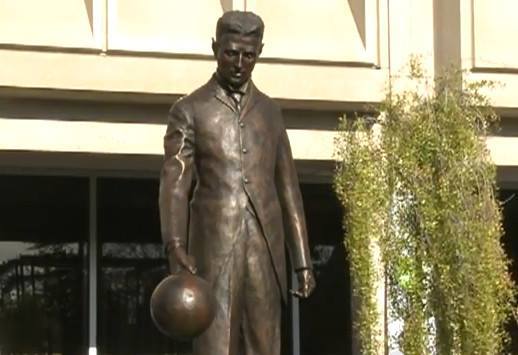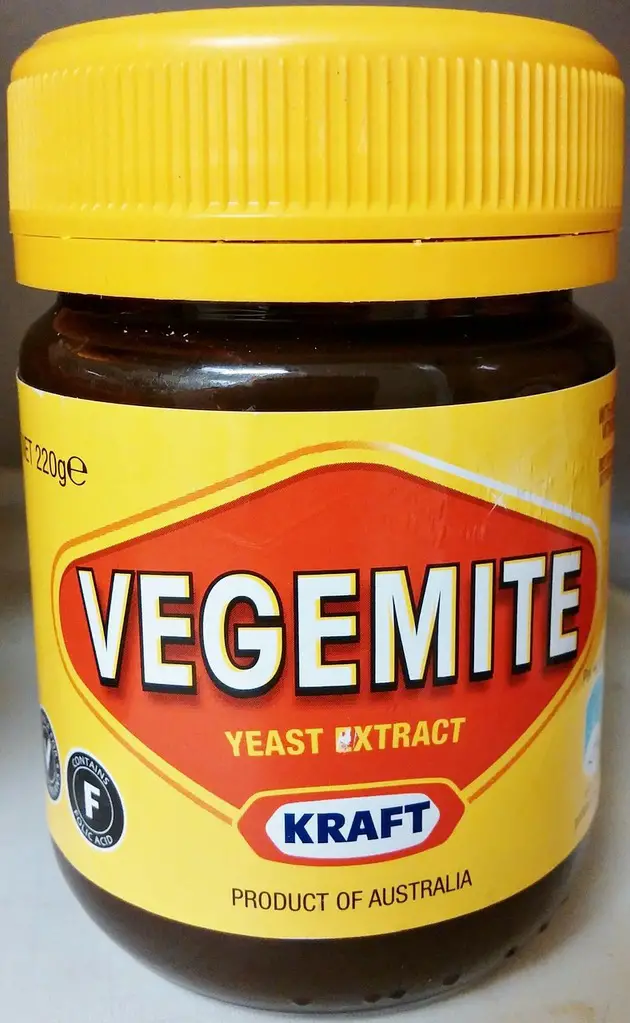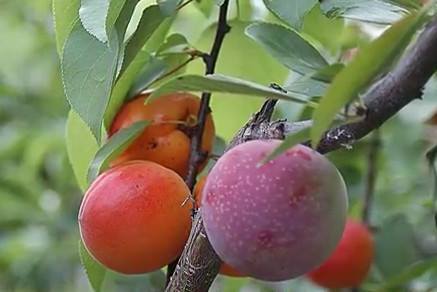 The weekly collection of random and fun facts. In this week’s edition: A Wireless Tesla Statue, VEGEMITE, British Tea Tanks, Fruit Salad Tree, and The Punt Gun.
The weekly collection of random and fun facts. In this week’s edition: A Wireless Tesla Statue, VEGEMITE, British Tea Tanks, Fruit Salad Tree, and The Punt Gun.
 Statues of famous and noteworthy people are a usual sight in a city or town, but one particular statue of Nikola Tesla in Palo Alto, California, in the heart of Silicon Valley, doesn’t just stand there and do nothing, it emits free Wi-Fi. It was unveiled on December 7, 2013 and was the idea of a local resident named Dorrian Porter. Porter raised $127,000 through a Kickstarter.com campaign in 30 days to fund the making of the statue. Having a statue of Tesla be a hub for Wi-Fi is rather fitting since he had proposed a wireless “World System” back in the early 1900s. It would have provided electrical energy around the world through wireless transmission. The statue also has a time capsule that is to be opened in 2043. Source, Source
Statues of famous and noteworthy people are a usual sight in a city or town, but one particular statue of Nikola Tesla in Palo Alto, California, in the heart of Silicon Valley, doesn’t just stand there and do nothing, it emits free Wi-Fi. It was unveiled on December 7, 2013 and was the idea of a local resident named Dorrian Porter. Porter raised $127,000 through a Kickstarter.com campaign in 30 days to fund the making of the statue. Having a statue of Tesla be a hub for Wi-Fi is rather fitting since he had proposed a wireless “World System” back in the early 1900s. It would have provided electrical energy around the world through wireless transmission. The statue also has a time capsule that is to be opened in 2043. Source, Source
 In case you didn’t know, VEGEMITE, the spread that is popular in Australia, is a paste made from left over brewers yeast extract that also contains a vegetable extract and spices. The Fred Walker Company (which became part of Kraft Food Company) hired an Australian chemist named Dr. Cyril P. Callister to develop the spread in 1922. It was known as “Pure Vegetable Extract” until The Fred Walker Company held a national competition in Australia for the public to name the spread. Fred Walker’s daughter chose the name VEGEMITE from the pool of entries picked as finalists in the competition. VEGEMITE was in grocery stores by 1923.
In case you didn’t know, VEGEMITE, the spread that is popular in Australia, is a paste made from left over brewers yeast extract that also contains a vegetable extract and spices. The Fred Walker Company (which became part of Kraft Food Company) hired an Australian chemist named Dr. Cyril P. Callister to develop the spread in 1922. It was known as “Pure Vegetable Extract” until The Fred Walker Company held a national competition in Australia for the public to name the spread. Fred Walker’s daughter chose the name VEGEMITE from the pool of entries picked as finalists in the competition. VEGEMITE was in grocery stores by 1923.
Marmite, a spread popular in Britain and also made from brewer’s yeast, was already being used in many Australian households, so this new product had difficulty taking hold. Fred Walker even changed the name from VEGEMITE to Parwill to compete with Marmite. The change was unsuccessful, however, and Walker later changed it back to VEGEMITE.
A few things had to happen for VEGEMITE to become the icon that it is of Australia today. A limerick competition helped improve sales of VEGEMITE in 1937, and the British Medical Association endorsed the product in 1939. It also gained popularity because it was associated with being rich in Vitamin B. World War II forced the rationing of VEGEMITE since the Australian Armed Forces were buying so much of it because of its nutritional value for the troops. The reduction helped cement its iconic status in Australia. You may have not ever eaten it if you’re not from Australia, but you’ve probably heard the reference “VEGEMITE sandwich” in the song “Down Under” by the Australian band, Men at Work. Source, Source, Source
 It may seem odd at first, but British tanks have facilities for making tea inside them. The British are known for their tea breaks, and even being inside a tank won’t be an obstacle to this cultural norm. British tanks have an electric boiling vessel that is used to heat ration pouches or tins. The vessel the water boils is even used for drinking, and in this case, for tea. The boiling vessels have been installed on every tank since World War II, staring with first tank produced after the war–the Centurion tank. The equipment allows the crew to stay safely inside while enjoying a nice cup of tea and is, no doubt, a good morale booster. Source
It may seem odd at first, but British tanks have facilities for making tea inside them. The British are known for their tea breaks, and even being inside a tank won’t be an obstacle to this cultural norm. British tanks have an electric boiling vessel that is used to heat ration pouches or tins. The vessel the water boils is even used for drinking, and in this case, for tea. The boiling vessels have been installed on every tank since World War II, staring with first tank produced after the war–the Centurion tank. The equipment allows the crew to stay safely inside while enjoying a nice cup of tea and is, no doubt, a good morale booster. Source
 It’s really not a joke, there is a tree called a Fruit Salad Tree that can have six different varieties of fruit, all on one tree. The trees were developed by James and Kerry West of Australia when they began grafting different fruit varieties to a single tree more than 20 years ago. One grafted plant is considered the root stock, or the one that has a strong root system, and the others are called scions, which are plants that are picked because of the type of fruit they produce. They are joined by a grafting technique where one plant is cut in a pattern that exposes its vascular system and is joined with that of the root stock plant. Of course it’s a bit more complicated than that, but when the pieces heal from the graft, the vascular systems are connected, and “voila!”, a Fruit Salad Tree is ready to grow.
It’s really not a joke, there is a tree called a Fruit Salad Tree that can have six different varieties of fruit, all on one tree. The trees were developed by James and Kerry West of Australia when they began grafting different fruit varieties to a single tree more than 20 years ago. One grafted plant is considered the root stock, or the one that has a strong root system, and the others are called scions, which are plants that are picked because of the type of fruit they produce. They are joined by a grafting technique where one plant is cut in a pattern that exposes its vascular system and is joined with that of the root stock plant. Of course it’s a bit more complicated than that, but when the pieces heal from the graft, the vascular systems are connected, and “voila!”, a Fruit Salad Tree is ready to grow.
The Fruit Salad Tree comes in four different types and each have a different type of fruit. Stone fruit trees have nectarines, plums, peachcots, peaches, and apricots. Citrus fruit trees have pomelo, grapefruit, lime, tangelo, lemon, oranges, and mandarin. Multi-apple trees come in red, green, and yellow, and Multi-nashis trees (Asian pears) come in rustic, green, and yellow varieties. A trip to the supermarket wouldn’t even be necessary. Source, Source
 The “Punt Gun” was a large shotgun used in the 1800s and early 1900s to shot large numbers of waterfowl for commercial harvesting. It could fire a pound of shot and bring down almost fifty birds at a time. It was largely banned by many states in the 1860s and was banned for good by a federal law in 1918. Source
The “Punt Gun” was a large shotgun used in the 1800s and early 1900s to shot large numbers of waterfowl for commercial harvesting. It could fire a pound of shot and bring down almost fifty birds at a time. It was largely banned by many states in the 1860s and was banned for good by a federal law in 1918. Source
That’s it for another edition. See you next time and remember to annoy those around you with your new knowledge.
Need more random facts? Check out more from the Random Facts of the Week.

